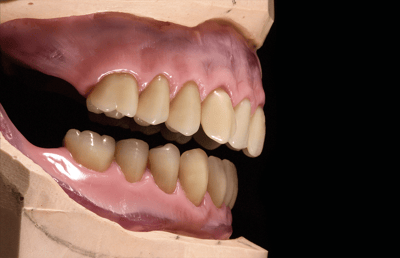The Patient’s Need: Economic Esthetics and Functionality
Daniel Lavrin, Dental Technician and Denturist
Listening to what patients want and need is a crucial factor for a successfull rehabilitation. When it comes to dentures, many older patients are looking for an economic solution. On the other hand, what they don’t want, is a denture that lacks functionality and esthetics. The following user report profiles how to accomplish efficient and economic esthetics and fuctionality with an established treatment protocol and denture teeth of choice.
The patient’s situation
A 72 year-old female patient presented in the office because she could not eat properly with her removable rehabilitations. The partial denture in the lower jaw broke several times and was uncomfortable and unstable. Because of that she stopped wearing it. Despite the age-appropriate bone atrophy, the remaining teeth, 32 and 33, did not show any signs of inflammation. Tooth 32 had a mobility of one. The patient wanted to keep both teeth and refused implants, which would have distributed the forces more evenly. The disadvantages of an uneven load and the accelerating effect on her remaining teeth were explained. The patient wanted to keep both teeth and refused implants, which would have distributed the forces more evenly. The disadvantages of an uneven load and the accelerating effect on her remaining teeth were explained.
Pretreatment
After anatomic impressions of the upper and lower jaw, models were fabricated on which individual trays were created for the mucodynamic impression. Master models were manufactered to be able to produce fitting bite registration plates with a wax rim to record the position of the mandible in relation to the maxilla and to transfer the midline, the canine position, the incisal length and expansion of the buccal corridor. According to the clinical bite registration, the two master models were articulated and the model analysis was performed.
Set up
VITA MFT Anterior was used for the set up in the anterior area. For a budget denture tooth, the anterior sets are very esthetic. They are designed naturally in morphology and texture. The anatomical structure is simulated with neck, dentine and enamel layers, which leads to a three-dimensional play of light and color.
Tooth axis and coordinated angle characteristics, according to the esthetic rules, make a quick match of the front teeth possible. Due to the position of the remaning canine and incisor, all lower teeth were used in addition to the natural incisor 32 to provide stability while eating with the new denture. So altogether, there were five lower central incisors established. The set up was performed edge to edge to the remaining natural teeth to improve the esthetics of the upper smile line.
In the molar region, the lingualized VITA MFT Posterior easily enabled finding the centric position and establishing buccal contacts, due to the multifunctional occlusal surface design. The lingualization of the teeth offered more space for the tongue and a more stable function on the atrophied jaw ridges. Extra care was also taken during the contouring of the lower lingual aspect to implement space and free movement of the tongue. During the try in, a final bite registration was taken with the set ups in order to recheck static and dynamic occlusion in the articulator.
Polymer transfer and outcome
After a succesfull clinical try in and final anatomical contouring, the rehabilitations were transferred into polymer. First, the set ups were duplicated with hydrocolloid. Then the teeth were cleaned, conditioned and repositioned in the hydrocolloid index. Before the flasking of the denture base with the auto-polymerizing and pourable Castdon Resin, internal colors of the DentureArt System (both Dreve Dentamid, Unna, Germany) were applied into the flask to simulate the appearance of the gingival anatomy. After the polymerization, finishing and polishing was performed. The new rehabilitations were inserted intraorally and checked by the practicioner and the patient. Both were very satisfied with the lifelike appearance and functional integration. The patient’s requirements of an economical, esthetic and functional rehabilitation were all met.

1. The remaining teeth, 32 and 33, did not show any signs of inflammation.

2. The set up in the esthetic zone with VITA MFT Anterior.

3. The lingualized VITA MFT Posterior provides more space for the tongue.

4. Easy centric with buccal contacts in the molar region.

5. The wax set up gave guidance during the clinical try in.

6. The lingualized VITA MFT Posterior provides more space for the tongue.

7. View on the final upper wax set up in the molar region.

8. The finally contoured wax set up in the upper jaw.

9. Altogether five lower central incisors were established to offer stability.

10. The palatal anatomy was also reproduced meticulously.

11. Both wax set ups in the articulator.

12. The upper and lower rehabilitations after their transfer into polymer.

13. Gingival anatomy was simulated with internal colors.

14. The new rehabilitation appeared very natural intraorally

15. The lifelike appearance and the functional integration of the rehabilitations
VITA Zahnfabrik H. Rauter GmbH & Co. KG
Spitalgasse 3
79713 Bad Säckingen
Germany
Phone: +49 7761 562 0
Hotline: +49 7761 562-222
E-Mail: info@vita-zahnfabrik.com
Contact GTB Data protection Imprint
©2024 VITA Zahnfabrik. All rights reserved.



